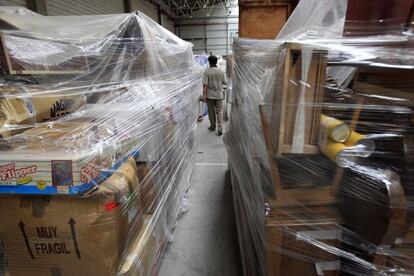City Hall’s 200 missing artifacts
Madrid says it will find lost paintings and other objects listed on its municipal inventory But most of the items have not been seen since 2003

The city of Madrid has lost track of nearly 200 works registered on the municipal inventory of historical and artistic goods. Nearly everything is known about these artifacts, including their economic value. Nearly everything, except for their current location, that is.
The missing pieces — paintings, sculptures, furniture, tapestries and more — are part of a catalogue of 6,700 items that belong to the city but are generally not part of specific museum collections, according to municipal sources. The catalogue is now undergoing review with the goal of publishing an updated version in March.
The city arts department, which manages this inventory, says that by March all the items will have been accounted for. Yet many of these 200 pieces, including the most valuable ones, have been missing since at least 2003.
There is a chandelier bought in 1945 for 1.5 million pesetas, the price of a house at the time
“There simply cannot be artworks whose location we don’t know,” says Jaime Lissavetzky, spokesman for the Socialist Party opposition on the city council. “I fear the worst, considering that the painting by Antonio de Felipe is not even catalogued, which is inconceivable. Somebody should be held accountable for this. It is yet another episode demonstrating the Popular Party’s lack of interest in culture.”
The reference to Antonio de Felipe involves the alleged disappearance of a painting by the contemporary pop artist, who left it in the hands of the city’s Retiro district council in 1996. Even though it was worth an estimated 12,000 euros at the time, it was not included in the list of historical and artistic assets. For years it hung inside the councilor’s office, until one day it simply wasn’t there anymore. Apparently, nobody knows where it might have gone.
Something similar may have happened to the 200 or so objects (198 according to City Hall, 209 according to this newspaper’s tally) whose location is described as “pending verification.” They might have been transferred to a different location without anybody noting down where, for instance. Or they might be sitting inside a warehouse, waiting for someone to return them to their original spot or some other place altogether. Or they might have been spirited away by thieves without the city ever noticing. The answer may well be a combination of these possibilities; in many cases, it might never actually be known. Whatever the facts, these are objects that belong to all Madrileños, and which the city has misplaced.
There simply cannot be artworks whose location we don’t know”
Besides their historical or artistic value, some also have an economic value. But the figures listed on the catalogue should be handled with care, since they reflect the price at which the item was purchased or what it was believed to be worth at the time of acquisition. For instance, a chandelier bought in 1945 for 1.5 million pesetas is listed as being worth the exact equivalent in euros, 9,000. Yet in 1945 that kind of money would have bought a nice house.
The inventory thus does not take inflation, and the artifact’s depreciation or appreciation, into account. Keeping this is mind, the total value of the items is listed as close to 600,000 euros, although of course it could be more, or less, in updated prices.
So what is on the missing list? There are two paintings from the Municipal Museum that were taken out in April 1992, and have not been heard about since at least 2003. There is also a neogothic silver candelabrum, two 19th-century wooden grandfather clocks, a two-meter chandelier made of glass and bronze, and a 12-meter rug. Even an entire meeting table with its 15 matching seats, worth an estimated 60,000 euros, has gone AWOL.
Also missing are 27 neoclassical sculptures from the 18th century that once stood inside the palace of the Duke of Osuna; a drawing by contemporary artist Eduardo Arroyo; a crucifix and a copy of the famous painting of Our Lady of the Dove, both dating from the 17th century, worth 30,000 euros apiece. A portrait of former Mayor Enrique Tierno Galván by José Luis de Palacio, worth an estimated 18,000 euros did reportedly turn up on Wednesday.
In 2003 — the year when many of these items were first reported missing — Alberto Ruiz-Gallardón, now the justice minister in Mariano Rajoy’s PP government, took over the mayor’s seat from José María Álvarez del Manzano, and immediately ordered a meticulous inventory of all the city’s assets, including property and art. In 2008 his team drew up instructions regarding how to list and de-list items from the catalogue.
With Ana Botella in power since January 2012, the city is committed to finding the missing items. But some of them have been gone for so long that perhaps it would be wisest to simply accept the losses and reflect them in the catalogue.







































